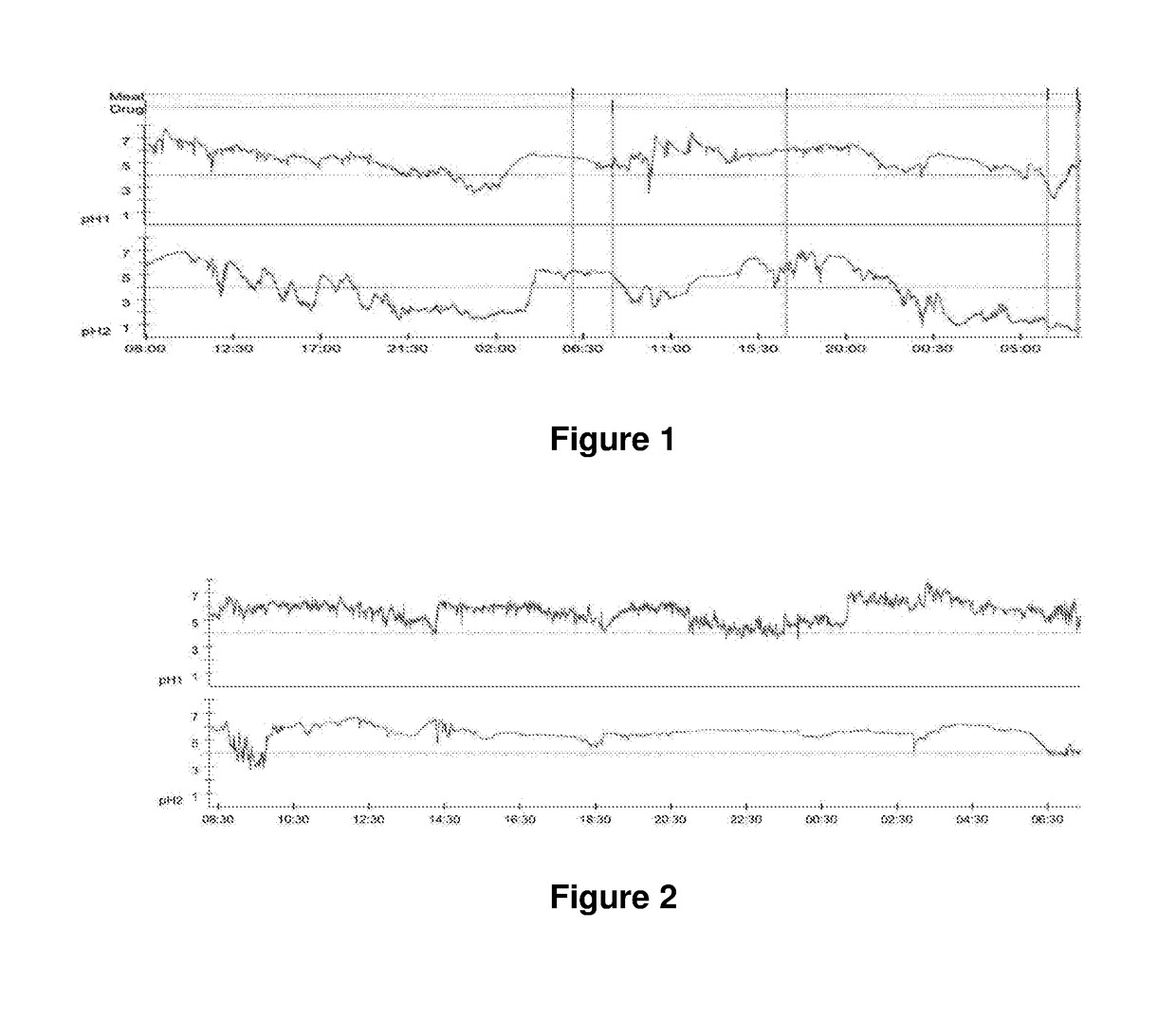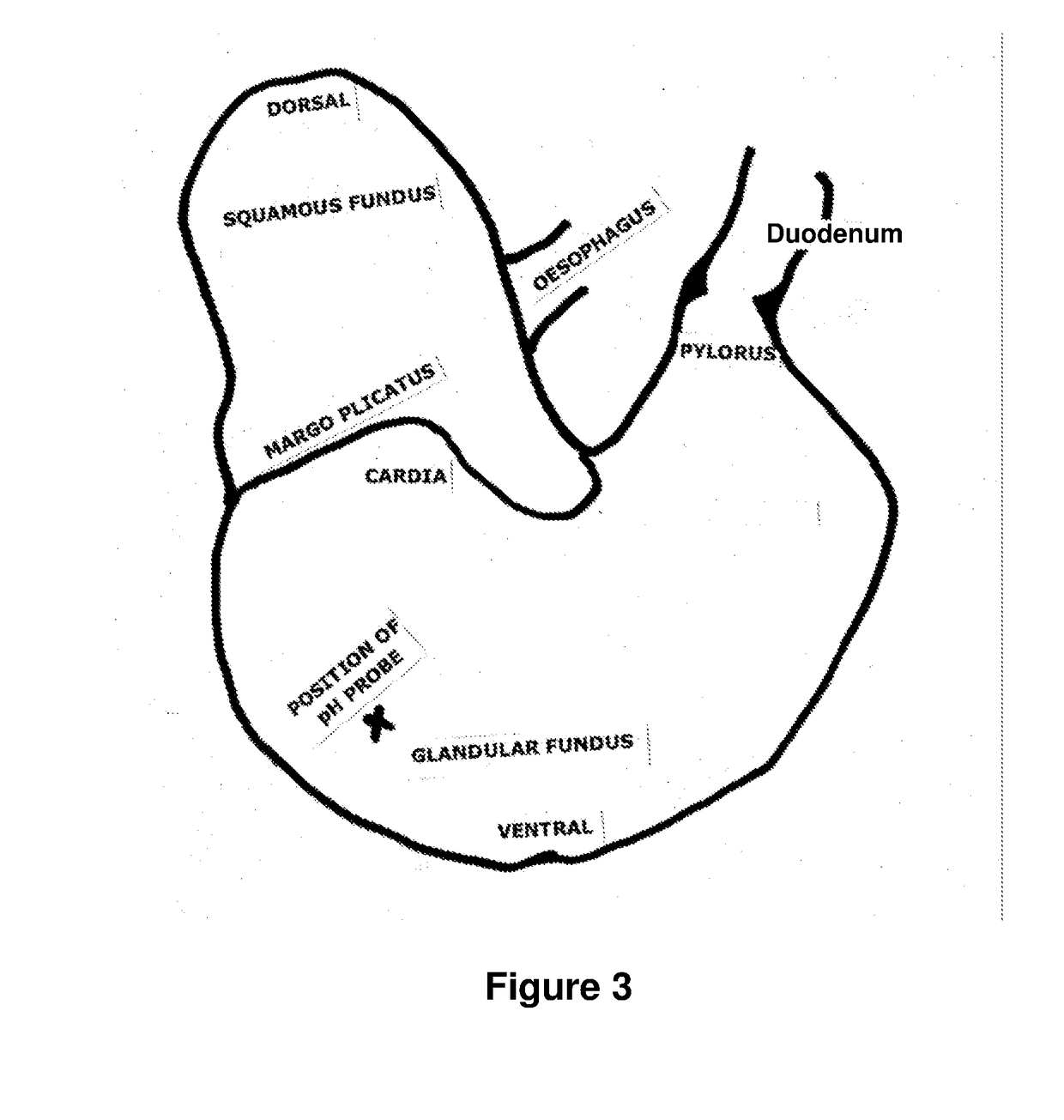Methods and compositions for treating gastric ulcers
a gastric ulcer and composition technology, applied in the field of gastric ulcer treatment methods and compositions, can solve the problems of difficult treatment, high egus risk, damage to the outer cell barrier, etc., and achieve the effect of quick degrad
- Summary
- Abstract
- Description
- Claims
- Application Information
AI Technical Summary
Benefits of technology
Problems solved by technology
Method used
Image
Examples
example 1
Preparation of an In-Situ Gel Based Intramuscular Injectable Formulation for Omeprazole
[0120]The formulation developed in this example has the following constituents.
TABLE 2IngredientQuantityOmeprazole (OMP)150 mg / mL (1.8 g)Poloxamer 407 solution25% w / v (3.0 g added to 12 ml of water)Drug: L-arginine1:1.5Autoclaved WaterQuantity Sufficient
Materials and Methods
[0121]A total of 3.0 g of Poloxamer 407 was added to 12 ml of autoclaved water and stored in a refrigerator (4° C.) to dissolve the poloxamer and convert the solution to a clear transparent liquid. A total of 1.8 g of OMP (lot#111101, Cleo Shang) and 2.7 g L-arginine in the ratio of 1:1.5 (OMP: L-arginine) were added to the above prepared transparent liquid and mix uniformly by vortex for 10 to 15 minutes. Vials were filled with the preparation and sterilized using gamma irradiation at 25 kGy. The intramuscular injectable formulation was stored at 4° C. and stored in an ice bucket immediately prior to injection.
example 2
Further Examples of Suitable Formulations for Intramuscular Injectable
[0122]In addition to the formulation of Example 1, the following formulations were also prepared:
TABLE 3OM00PC003FormulationL-Arginine(Omeprazole -CodeVehicle(mg / ml)mg / ml)CommentsF4Peanut oil (Long chain15010016 G / 18 GOM03IM025triglyceride; Non-aqueous)needles canbe usedF3Miglyol 812 (medium chain150100OM03IM026triglyceride; Non-aqueous)F1Sesame oil (Long chain150100OM03IM029triglyceride; Non-aqueous)F6Captex 355 (medium chain150100OM03IM033triglyceride; Non-aqueous)F5PVP K30 (Aqueous)150100Needle14 G
[0123]Formulations containing 200 mg / ml of omeprazole were also prepared.
Materials and Methods
[0124]The required quantities of sesame oil, peanut oil, Miglyol 812, Captex 355 were measured and allocated. Omeprazole was filtered through a 250 mesh sieve to provide uniform particles and uniformity in the formulations. L-arginine was also filtered through a 150 mesh sieve to provide uniform particles. L-arginine is added...
example 3
Investigation into the Long Acting Formulation of Omeprazole in a Single Healthy Horse
[0126]A previous report (Merritt et al 2003) and preliminary investigations by the research group have indicated that the duration of intragastric acid suppression achieved with currently available forms of omeprazole may be a short as 12 hours. A 48 h continuous trace is presented in FIG. 1.
[0127]The duration of acid suppression required for healing of gastric ulceration in humans is a minimum of 16 hours per day (Bell et al 1992). These findings suggest that the currently available formulations of omeprazole may be inadequate for this purpose. To address this, a long acting injectable formulation of omeprazole has been developed. This report details the preliminary investigations into the efficacy of the formulation.
Materials and Methods
[0128]A 10 year old, 550 kg thoroughbred gelding was instrumented with a percutaneous gastrostomy (PEG) tube using a modification of the technique previously repo...
PUM
| Property | Measurement | Unit |
|---|---|---|
| concentration | aaaaa | aaaaa |
| concentration | aaaaa | aaaaa |
| concentration | aaaaa | aaaaa |
Abstract
Description
Claims
Application Information
 Login to View More
Login to View More - R&D
- Intellectual Property
- Life Sciences
- Materials
- Tech Scout
- Unparalleled Data Quality
- Higher Quality Content
- 60% Fewer Hallucinations
Browse by: Latest US Patents, China's latest patents, Technical Efficacy Thesaurus, Application Domain, Technology Topic, Popular Technical Reports.
© 2025 PatSnap. All rights reserved.Legal|Privacy policy|Modern Slavery Act Transparency Statement|Sitemap|About US| Contact US: help@patsnap.com



